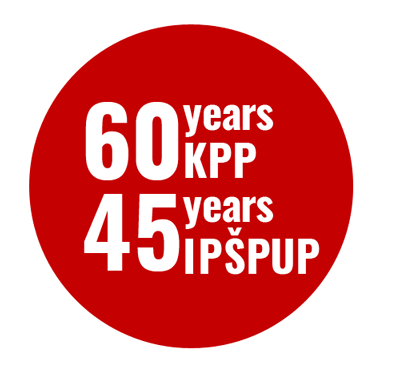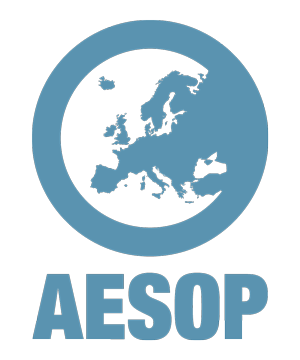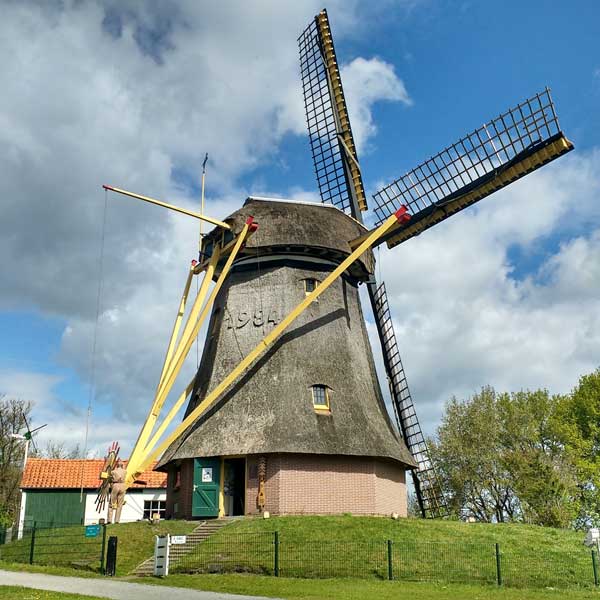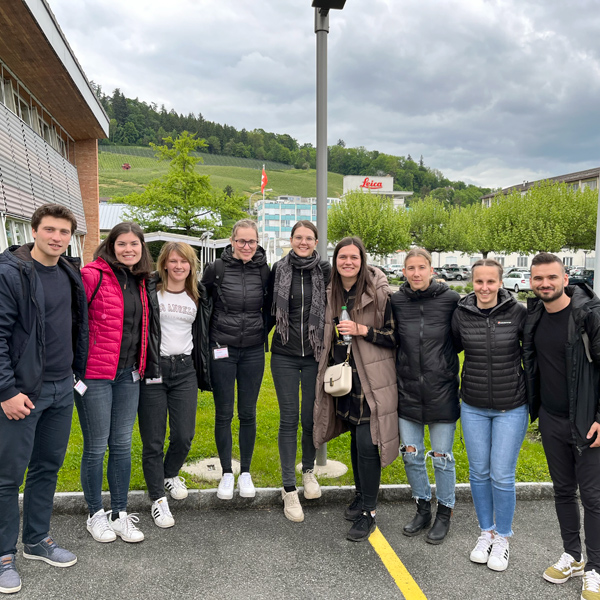Chair of Spatial Planning
Katedra za prostorsko planiranje (KPP)
The Chair of Spatial Planing currently has five full-time employees: two assistant professors, senior lecturer, assistant and technical assistant. The Chair also continues to cooperate with Dr. Anton Prosen, retired associate professor.
Within the Department of Geodesy, the Chair of Spatial Planning manages the master study programme Spatial Planning (MA).
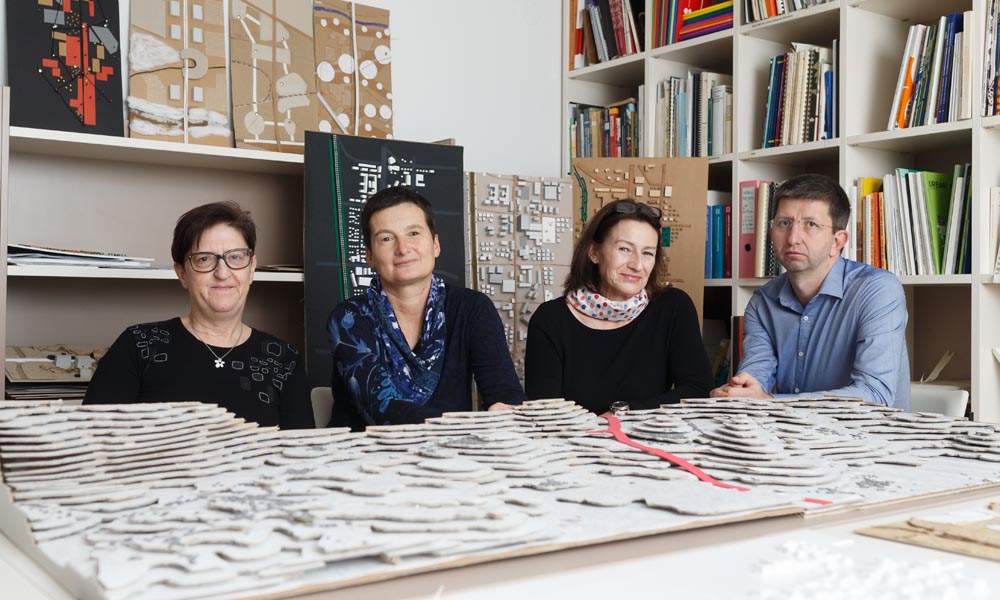
SPATIAL PLANNERS OF THE 21st CENTURY
In 2018 it were two anniverseries: 60 years of the Chair of Spatial Planing and 45 years since the establishment of the Interdisciplinary Post‑graduate Study of Spatial and Urban Planning (IPŠPUP). We marked the occasion with the event and a publication.
| List of Employees | Phone | ||
|---|---|---|---|
| asist. | Jana Breznik, mag. prost. načrt. | jana.breznik@fgg.uni-lj.si | |
| doc. dr. | Gregor Čok, univ. dipl. inž. arh. | +386 1¸4768 645 | gregor.cok@fgg.uni-lj.si |
| viš. pred. dr. | Mojca Foški, univ. dipl. inž. geod. | +386 1 4768 529 | mojca.foski@fgg.uni-lj.si |
| asist. dr. | Gašper Mrak, univ. dipl. inž. arh. | +386 1 4768 646 | gasper.mrak@fgg.uni-lj.si |
| Konstanca Soss, inž. obl. teks. in oblač. | +386 1 4768 531 | konstanca.soss@fgg.uni-lj.si | |
| doc. dr. | Alma Zavodnik Lamovšek, univ. dipl. inž. arh. | +386 1 4768 642 | alma.zavodnik@fgg.uni-lj.si |
Hosting a post-doc (for the MSCA COFUND EUTOPIA-SIF):
Current projects, the Chair as project leader:
Current projects in which the Chair is cooperating:
Past projects that Chair was involved in:
AESOP HoS Meeting, Ljubljana, 2019
The 14th AESOP Head of Schools meeting was in March, 2019, hosted by University of Ljubljana, jointly by the Faculty of Civil and Geodetic Engineering, Chair of Spatial Planning, and Biotechnical Faculty. More info on the meeting’s webpage.
Educational activity
From its very foundations one of the main purposes of the Chair’s educational activity has always been to qualify experts with adequate skills of connecting geodesy, civil engineering, urbanism and spatial planning in individual projects, management and governance of space, and management of spatial policies. For many years the main focus of our teaching was education at the Interdisciplinary Graduate Study Program Urban and Spatial Planning. With the Bologna reform of study programs we formed a new second cycle study program Spatial Planning, which distributed the focus of our teaching to the master and doctoral studies. Within the master study program we use different teaching methods to offer our students quality education and findings about practical issues (project and field work, work in interdisciplinary groups) as research area (learning about various methods of spatial planning and spatial research). Evidence of well-prepared quality study program can be seen in awards bestowed to our students in Slovenia and abroad. In 2014 Uroš Rozman, one of the first graduates from the second cycle master study program Spatial Planning, received the University Prešeren Award.
At the third cycle doctoral study program our efforts are focused mainly on the excellence of research work, specifically on the issues of urban and regional spatial development, development of usages in space and other issues related to the wider research (program) group of the Department of Geodetic Engineering.
Research activity
The Chair of Spatial Planning is very actively involved in the international research work, especially in European projects of the ESPON program (https://www.espon.eu). Worth mentioning were especially the ESPON TANGO project, which was targeted towards the development of practical recommendations for the public management and governance of space, based on the present European practice. At the same time we were also implementing the 7th Framework project TURAS, with the aim to design and develop European cities (including their rural background) in such way that they could resist all important sustainability challenges. Researchers, local communities and companies from 16 towns and 11 European countries responded to new challenges of urban reality by searching for the right answers. Common efforts of all project partners followed the main goal, which was to form a new strategy for urban resilience and sustainable development with the purpose to decrease the urban ecological footprint. In the international area we also cooperated in the project of the European transnational program for South-East Europe Attract-SEE, where we proposed a holistic approach to monitoring conditions in the space. One of the expert tasks was the elaboration of municipal spatial plan for the Municipality of Ajdovščina.
ESPON program 2007 -2013 (www.espon.eu)
TANGO: Territorial Approaches for New Governance
ESPON POLYCE (2010-2012) www.polyce.eu
Chair's Past
In the last fourty years spatial planning has been developing as part of geodesy and has greatly contributed to the versatility of the geodetic and municipal professions. The beginnings of the Chair of Spatial Planning go back to 1958, when the Chair of Municipal Technology was established at the Faculty of Architecture, Civil and Geodetic Engineering. The first head of the Chair, Prof. Dr. Sedlar, belonged to the generation of functionalistically oriented architects – town planners. At that time (as well as later on) the Department of Architecture was not inclined to urban planning. For this reason this educational activity found its place at the Geodetic-Municipal Department of that faculty, established in 1956.
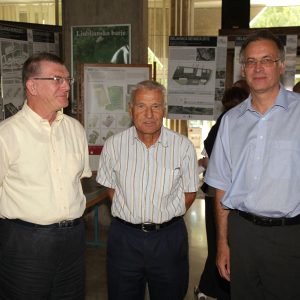
Former professors at Chair of Spatial Planning, Assoc. Prof. Anton Prosen, PhD (left), and Prof. Andrej Pogačnik, PhD (middle) with the Dean of Faculty of Civil and Geodetic Engineering in Ljubljana, Prof. Matjaž Mikoš, PhD.
In that time the study of geodesy no longer fulfilled all the requirements of spatial planning. For this reason, several Slovenian municipalities and the Republican Secretariat for Urban Planning, Municipal Affairs and Housing suggested to add to the study programmes some courses from infrastructural engineering and courses from town planning and municipal economics. The aim of the changed study was to train experts that would be able to connect the professions of geodesy, civil engineering and town planning for the purpose of implementing individual projects, manage space and conduct municipal policies.
The educational area of town planning diversified intensively in the next few years. Thus, in 1964 the Chair of Urban Planning was established. At that time it only had two members (Prof. Sedlar and Assist. Novak). With the years that followed, it became evident that the educational and research work should also expand to agricultural space, municipalities and regional space. For this reason, in 1978 the chair was renamed to more recognisable Chair of Spatial Planning, which is still active under this name as educational and research unit.
Chair of Spatial Planning: Achievements and Challenges over the Years
Prof. Dr. Andrej Pogačnik, long-standing Head of KPP and IPŠPUP
Establishment and functioning of the Chair of Spatial Planning
The establishment of the Chair of Spatial Planning at the Faculty of Civil and Geodetic Engineering of the University of Ljubljana was the consequence of rapid urbanisation in Slovenia in the late 1960s. At the time, large new towns were built – Nova Gorica, Velenje, Murska Sobota, as well as many new residential quarters and industrial areas in Ljubljana, Maribor, Kranj, and Koper, while neighbourhoods with single-family houses in the suburbs and the countryside grew uncontrollably. The leading architects, i.e. urban planners, of the time, such as Ravnikar, Mihevc, Novak, and Grabrijan, were successful in urban planning using the principles of functionalism, but there were no experts in municipal infrastructure, transport, urban economics, sociology, law, environmental protection. The profile of interdisciplinary-oriented urban planners was to be educated by the Chair of Municipal Technology, which was newly established in 1958 ‒ this was the predecessor of the Chair of Spatial Planning. Formally it was included in the Geodetic and Municipal Department of the Faculty of Architecture, Civil Engineering, and Geodesy (UL FAGG), which was established two years previously (1956), which provided the appropriate academic environment for its successful operation. The chair fostered connections particularly with chairs and institutes for municipal economics, transport, and hydraulic engineering of the former UL FAGG. The contacts with the Chair of Urbanism at the Department of Architecture were weak and ceased completely after the separation of architecture and civil engineering and establishment of an independent faculty after Slovenia’s independence.
The founder and the first head of the chair was architect – professor Saša Sedlar, politically and professionally renowned personality in the then Socialist Republic of Slovenia. The professor left a mark on Slovenian, Yugoslav, and also international environments. He prepared the first lecture notes for a contemporary urban design textbook, following the model of Serbian colleagues Mirkovič and Maksimovič. He was very popular among students, but his lectures only reached a narrow circle of young surveyors and municipal civil engineers. Along with Prof. Sedlar, Assist. Novak was also involved at the start of the Chair’s operation. Lecturers from other chairs, departments, or faculties were included in the teaching process – geographer Vrišek, legal expert T. Klemenčič, transport engineer Zemljič, landscape architect Ogrin, and others.
The education in urbanism continued to take shape and in 1964 the Chair for Urban Planning was established. Assist. Novak was replaced in 1972 by Assist. Pogačnik with a Masters degree from the United States and with practical experience in the then Ljubljana Urban Planning Institute. Over the years the necessity to expand the teaching and research work to rural areas, municipalities, and regions became evident. To this end, in 1978 the Chair was renamed into a more recognisable Chair of Spatial Planning (hereinafter: KPP) which is as an educational and research unit still active today. After the untimely and sudden death of Prof. Sedlar, the Chair was taken over by Pogačnik, who headed it for the next 37 years, until his retirement in 2012.
Staff and educational activities as part of undergraduate study programmes
Chair’s staff numbers increased over the years. Assist. Dimitrovska Andrews, later Director of Urbanistični inštitut, Assist. Čuček Kumelj, later employed at the Ministry of the Environment and Spatial planning, Assist. Čerpes, later Assistant Professor at the Faculty of Architecture of the University of Ljubljana, Zavodnik Lamovšek, later Assistant Professor and Head of KPP, Assist. Žaucer, and Assist. Gašper Mrak were all employed in the central, urban planning field. The second teaching position in the field of rural planning was filled by the now retired Assist. Prof. Prosen with Assist. Foški, the current head of KPP. Thus the number of staff at KPP in the years up to the Bologna Reform consolidated, with the inclusion of young researchers and other professionals.
In line with its doctrine of interdisciplinary education, KPP included lectures from a broad spectrum of areas. Prof. Černe (regional planning), Prof. Marušič (landscape planning), Prof. Pličanič (law), Prof. Kovač (economy), Prof. Plut (ecology), and others, were also involved. From UL FAGG chairs and the later independent Faculty of Civil and Geodetic Engineering (UL FGG), municipal topics were covered by Prof. Rakar and Assoc. Prof. Šubic Kovač, transport planning by Assist. Prof. Lipar, and others. Prof. Naprudnik, Prof. Jeršič, and others regularly held thematic lectures.
On the occasion of KPP’s anniversary it is worth mentioning that this is now the third generation of teachers and educators. The first generation (unfortunately now late) professors were Sedlar, T. Klemenčič, Vrišer, Čuček, Zemljič. The second generation, now largely retired, consisted of Pogačnik, Prosen, and Naprudnik, and the third one of Zavodnik Lamovšek, Foški, and Mrak. The Chair’s teachers were involved in the education process at other universities or faculties: the study programme in landscape architecture at the Biotechnical Faculty, at the Faculty of Architecture, geography at the Faculty of Arts, at the Faculty of Civil Engineering of the University of Maribor, and, elsewhere in Yugoslavia, particularly in post-graduate study programmes in Belgrade, Zagreb, and Sarajevo.
As mentioned, in the first decade of its existence, KPP’s teaching activities were mostly underway in the Surveying Municipal Department and later under the Spatial Orientation at UL FGG’s Department of Geodesy. This somehow narrowed down its influence, scope, and mission. Its graduates – surveyors were particularly trained for interdisciplinary management of drawing up spatial plans, urban management, rural renovation, work in real-estate companies, and for geoinformation services. Thus they filled the gap between the professional areas that were otherwise occupied by architects, geographers, and landscape architects.
Many textbooks, lecture notes, and monographs in urbanism, regional planning, restructuring of rural areas, and urban ecology were provided, with which the authors were trailblazers in many fields, as previously there was no Slovenian professional literature available. As authors of various chapters they contributed to various proceedings, monographs, and other professional publications published elsewhere. Their contribution was evident in urban planning dictionaries. Scientific, professional, and popular articles written by KPP staff were regularly published in journals Sinteza, Arhitektov bilten, Urbani izziv, Geodetski vestnik, in Yugoslavian scientific and professional journals, in prominent foreign journals Computer-aided Design, Urban Ecology, Town and Country Planning, Geografický časopis, and in monographs published by renowned publishing houses, i.e. Ashgate Pergamon and Springer.
In time, and in particular after Slovenia’s independence, the study programme in spatial planning, headed by KPP, grew apart from other related, but competitive, programmes. First, this happened as an orientation in years 3 and 4 of the study programme in Geodesy, later as an independent study programme at the second-cycle Bologna level for the title of Master of Science in Spatial Planning, which could be continued up to the doctoral degree. The Bologna Reform eased the enrolment from other faculties, particularly after the completion of the first cycle. Admittedly, the programmes of other faculties were becoming increasingly competitive. Let us mention the completely separate study programme in Urbanism at the Faculty of Architecture of the University of Ljubljana and related fields of study at the Department of Geography of the Faculty of Arts at the University of Ljubljana and the Department of Landscape Architecture at the Biotechnical Faculty of the University of Ljubljana, the orientation in urbanism at the Faculty of Civil Engineering of the University of Maribor and the Real-Estate Management at the University of Nova Gorica.
Graduation works at KPP mostly covered topics in analytical urbanism, spatial planning, rural planning, ecology, urban economics, property management, and similar. They also covered topics in spatial sociology, particularly in the form of surveys and other forms of collaboration with local residents, and, in recent years, topics of sustainable spatial development. The students often picked subject themes relevant to their hometowns, at the initiative of municipalities or local design studios. Thereby they were beneficial to solving professional problems, particularly in remote smaller towns that otherwise did not receive any special attention. Many student workshops and seminars applied theoretical elements of the courses on practical case studies, e.g. Muta, Kranjska Gora, Šentrupert, etc.
The speech was part of the round table in 2018, when the Chair of Spatial Planning celebrated two important anniversaries, 60 years since the established of the Chair of Municipal Technology – KPP’s – Chair’s predecessor – and 45 years since the establishment of the Interdisciplinary Post‑graduate Study of Spatial and Urban Planning (IPŠPUP). Full text is available here..
Chair of Spatial Planning - A View towards the Future
Sen. Lect. Dr. Mojca Foški, Head of KPP Chair
Establishment and functioning of the Chair of Spatial Planning in the new millennium
The establishment and development of the Chair of Spatial Planning (KPP) and the Interdisciplinary Post‑graduate Study of Spatial and Urban Planning (IPŠPUP), from their early days to their transition to the Bologna system, was described by Prof. Pogačnik in the introduction to this monograph (Achievements and Challenges over the Years). Prof. Pogačnik and Assist. Prof. Prosen were, until their retirement in 2012 and 2010, respectively, the drivers of educational, scientific, and professional development of KPP. We, their successors, feel obliged to continue the development of the Chair in all fields of its operation. We hold a special responsibility in the educational domain by taking care of the study programme Spatial Planning, which succeeded its much more recognisable older brother – IPŠPUP.
Many societal changes, and particularly the economic crisis during 2008‒2014, contributed, after both professors retired, to the lack of new employments at KPP. Nowadays, the staff consists of only three educators (doc. dr. Alma Zavodnik Lamovšek, viš. pred. dr. Mojca Foški, and asist. dr. Gašper Mrak). Nevertheless, we continue to transfer knowledge in spatial planning to younger generations. We teach courses in spatial, regional, urban, and rural planning in almost all UL FGG’s study programmes, along with the second-cycle study programme Geography (UL FF) and the first-cycle study programme Urbanism (UL FA). In the past, Dr. Maja Simoneti helped with our educational and research activities, while Mag. Nataša Pichler Milanović was involved in international research activities and Miha Konjar was a young researcher. Ms Konstanca Soss has been helping us as a technical assistant all along. In recent years, the shortage of staff is addressed by involving teachers from other members of the University of Ljubljana, the Slovenian Academy of Sciences and Arts, and in collaboration with the Faculty of Architecture in Zagreb. Renowned professionals are invited to take part, who, with their thematic lectures, show their experience in current spatial planning practice.
Despite staff problems, we continuously introduce new tools and methods into our teaching process, which was also the subject of several publications in journals concerned with the topic of teaching methods in higher education (e.g. Sodobna pedagogika) published by us or in collaboration with guest teachers. The emphasis is on interdisciplinarity and project-based learning, which requires from educators and students more input in terms of content, organisation, and time; nevertheless, the learning outcomes are better than if using conventional teaching methods and students’ satisfaction is greater. The most efficient format of project-based learning is student workshops, which have been held each year since 1998. Since 2012 these workshops are international which particularly contributes to connections between students and teachers of similar orientations from different study programmes and different countries, allows for exchange of knowledge and practical experience, and improves the teaching process. Most results of these student workshops were published in professional monographs (available at https://www.researchgate.net/; in the COBISS system).
During studies, the students are encouraged to take part in various domestic and international research and project tasks, competitions, and summer schools. Our focus is particularly on involvement in projects Along the Creative Path to Practical Knowledge, co-financed by the ministry responsible for education, where teachers from KPP take part as mentors.
A big step toward independent work for any student is the production of the final paper; KPP is proud of its many supervisions and the diversity of final works at various study levels (from professional to doctoral) and in various study programmes. We also boast two Prešeren Awards (Rozman – 2014 University Prešeren Award and Dolinšek – 2016 Faculty Prešeren Award) under the supervision of doc. Zavodnik Lamovšek.
Regardless of the extensive teaching work and the economic crisis that strongly affected our field as well, our professional work and scientific research have not been neglected. In the professional domain we mostly collaborate in drawing up professional background documents for the needs of spatial planning at the local level, in production of various expert opinions and reviews, and in the tasks put up for tender by the ministry responsible for space. Here we maintain, to the extent possible, collaboration with municipalities and the companies concerned with spatial planning, as this brings us together with the current challenges of spatial planning practice, at the same time preventing us to remain solely inside isolated academic circles.
Over the last few years, the prevailing research topics have been urban and regional development, development of methodological tools, and definition of spatial development concepts and models, which we particularly address under Target Research Programmes (CRPs) funded by the Slovenian Research Agency (ARRS). Depending on the interests of individual ministries and their sectors we prepare professional works in the wider field of professional planning. Since the late 1990s we have been strongly involved in international research. In the period before Slovenia’s accession to EU, we were among the first ones in Slovenia to take part in the European Observation Network for Territorial Development and Cohesion (ESPON, www.espon.eu) and in Interreg programme projects, transnational territorial cooperation projects, Urbact, Leonardo da Vinci, and the 7th Framework Programme. Here too the topics focused on the development of settlement, cities, and urban regions or implementation of the proposed spatial development. Our involvement in international projects almost ceased over the last few years as during 2014–2017 Zavodnik Lamovšek was strongly involved in UL FGG managerial tasks as the Vice-Dean for Student Affairs.
We maintain contacts with the professional and international community through active membership in domestic and international associations, either as individuals (the Town and Spatial Planning Association of Slovenia, the Association of Surveyors of Slovenia, the Association of Architects of Ljubljana) or institutionally (the Association of European Schools of Planning – AESOP). In 2019, UL FGG will host (together with UL BF) the 14th AESOP Heads of Schools Meeting. All of the time we have been an active part of civil initiative in the field of spatial planning (e.g. Odgovorno do prostora! – Acting Responsible to Space!).
The speech was part of the round table in 2018, when the Chair of Spatial Planning celebrated two important anniversaries, 60 years since the established of the Chair of Municipal Technology – KPP’s – Chair’s predecessor – and 45 years since the establishment of the Interdisciplinary Post‑graduate Study of Spatial and Urban Planning (IPŠPUP). Full text is available here.
Study tours for students of Spatial Planning:
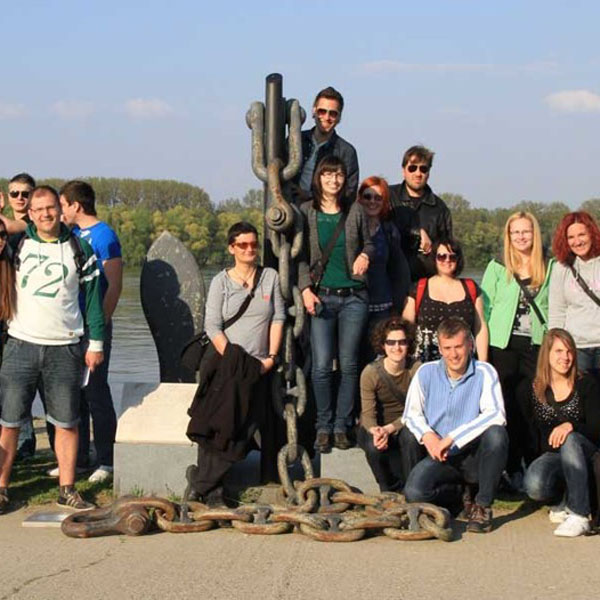
Study tour to Osijek, Croatia, for students of Spatial planning
May, 2013
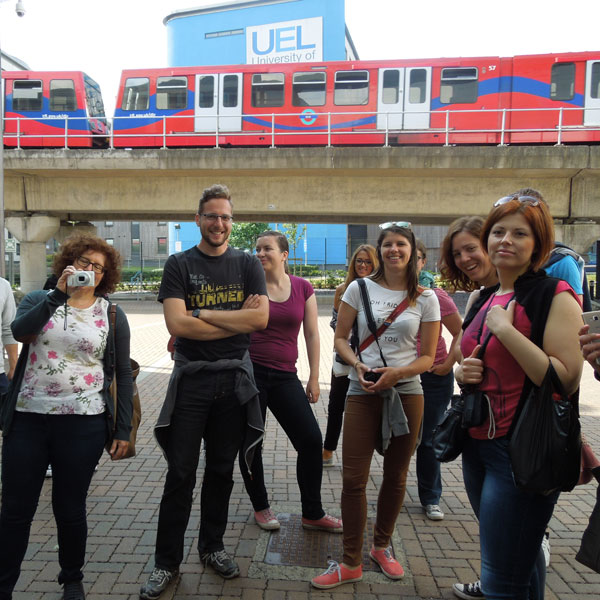
Study tour to London for students of Spatial planning
June 2015
Study tour to Holland with students of Spatial planning and Surveying
May 2017, (in Slovenian)
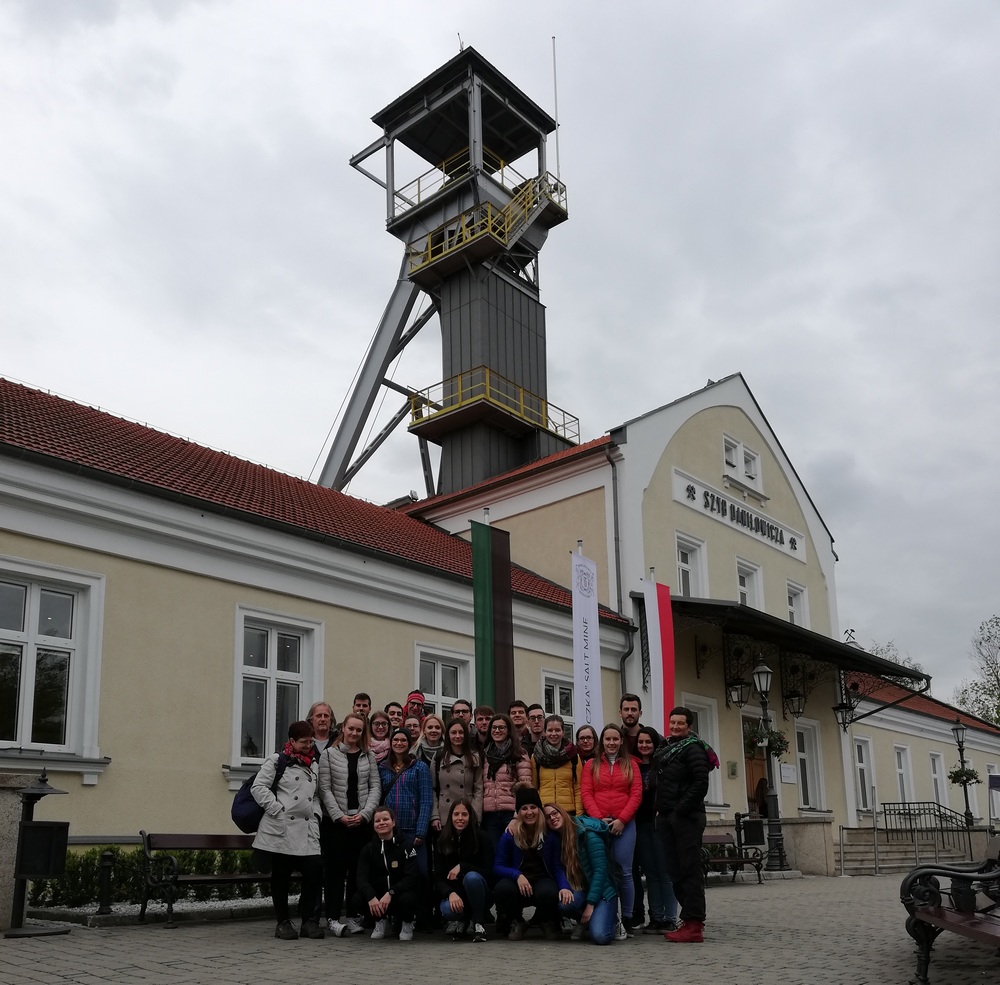
Study tour to Krakow, Poland, with students of Spatial planning and Surveying
May 2019, (in Slovenian)
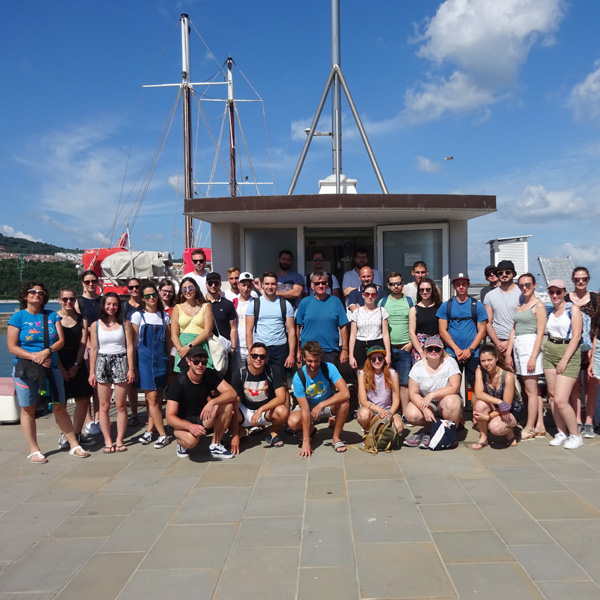
Study tour for students of Spatial planning and Surveying around Slovenia
May, 2021

